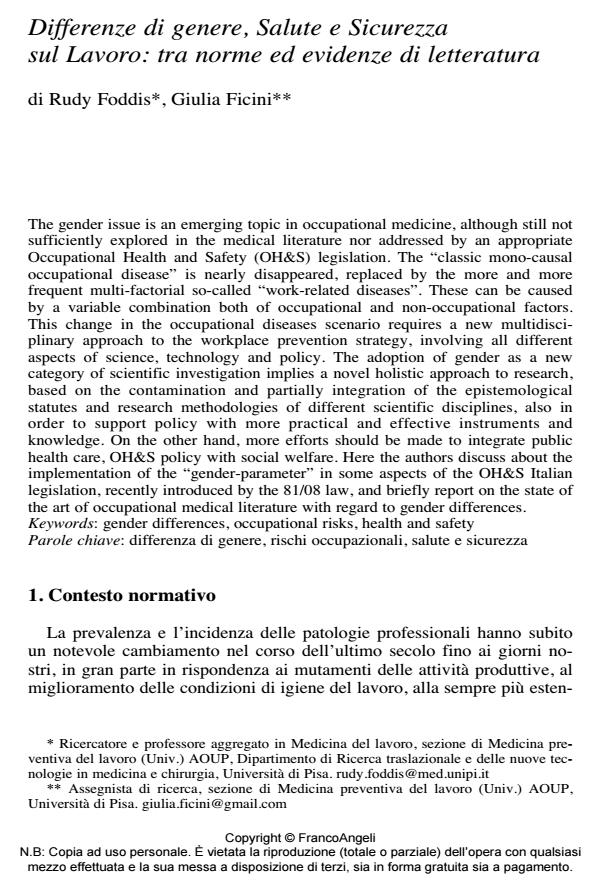Differenze di genere, Salute e Sicurezza sul Lavoro: tra norme ed evidenze di letteratura
Titolo Rivista SALUTE E SOCIETÀ
Autori/Curatori Rudy Foddis, Giulia Ficini
Anno di pubblicazione 2014 Fascicolo 2014/1
Lingua Italiano Numero pagine 13 P. 168-180 Dimensione file 525 KB
DOI 10.3280/SES2014-001014
Il DOI è il codice a barre della proprietà intellettuale: per saperne di più
clicca qui
Qui sotto puoi vedere in anteprima la prima pagina di questo articolo.
Se questo articolo ti interessa, lo puoi acquistare (e scaricare in formato pdf) seguendo le facili indicazioni per acquistare il download credit. Acquista Download Credits per scaricare questo Articolo in formato PDF

FrancoAngeli è membro della Publishers International Linking Association, Inc (PILA)associazione indipendente e non profit per facilitare (attraverso i servizi tecnologici implementati da CrossRef.org) l’accesso degli studiosi ai contenuti digitali nelle pubblicazioni professionali e scientifiche
The gender issue is an emerging topic in occupational medicine, although still not sufficiently explored in the medical literature nor addressed by an appropriate Occupational Health and Safety (OH&S) legislation. The "classic mono-causal occupational disease" is nearly disappeared, replaced by the more and more frequent multi-factorial so-called "work-related diseases". These can be caused by a variable combination both of occupational and non-occupational factors. This change in the occupational diseases scenario requires a new multidisciplinary approach to the workplace prevention strategy, involving all different aspects of science, technology and policy. The adoption of gender as a new category of scientific investigation implies a novel holistic approach to research, based on the contamination and partially integration of the epistemological statutes and research methodologies of different scientific disciplines, also in order to support policy with more practical and effective instruments and knowledge. On the other hand, more efforts should be made to integrate public health care, OH&S policy with social welfare. Here the authors discuss about the implementation of the "gender-parameter" in some aspects of the OH&S Italian legislation, recently introduced by the 81/08 law, and briefly report on the state of the art of occupational medical literature with regard to gender differences.
Parole chiave:Differenza di genere, rischi occupazionali, salute e sicurezza
- Migliorare la salute delle donne nei luoghi di lavoro: aspetti normativi e gestione dei rischi. Una ricerca in Toscana Rita Biancheri, Silvia Cervia, in STUDI ORGANIZZATIVI 1/2015 pp.44
DOI: 10.3280/SO2015-001003 - [Risk assessment and health surveillance from a gender perspective: proposal for operational tools] Rudy Foddis, Giulia Ficini, Alfonso Cristaudo, Alessandra Pistelli, Annalaura Carducci, Elisa Caponi, Rita Biancheri, Antonella Ninci, Chiara Breschi, Andrea Cristaudo, Antonella Basso, Roberta Bonfiglioli, Francesca Larese Filon, Silvia Simonini, Giovanna Spatari, Paola Tomao, Maria Gabriella Verso, Maria Luisa Scapellato, in Giornale Italiano di Medicina del Lavoro ed Ergonomia /2025 pp.214
DOI: 10.4081/gimle.635
Rudy Foddis, Giulia Ficini, Differenze di genere, Salute e Sicurezza sul Lavoro: tra norme ed evidenze di letteratura in "SALUTE E SOCIETÀ" 1/2014, pp 168-180, DOI: 10.3280/SES2014-001014